|
GREEN
FLASH Updated 11/14/2022 Jan Null, CCM |
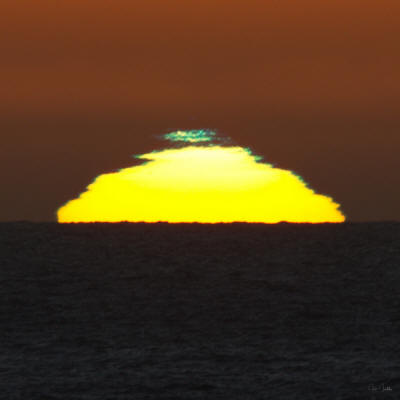 |
|
| The Green Flash is an
optical phenomena that occurs when light from the setting (or rising)
sun (or moon!) is
separated (i.e., refracted) through layers of the lower atmosphere. The
refraction is enhanced when layers of different density air causes
mirages in the lower atmosphere. This is most likely to happen on warm,
calm days when an inversion is created by a layer of warmer air
being just above cool air sitting over cool upwelled waters; like
along much of the California coast. It occurs at sunset (and yes sunrise) when the angle of the sun's rays are lower and have to pass through a longer length of the atmosphere. The blue and green light are bent more than the longer wavelength reds and oranges, and appear higher in the sky. Blue flashes are extremely rare as blue light is mostly scattered by molecules in the atmosphere.
Seeing the Green Flash In over 45-years as a meteorologist and looking for the Green Flash, I never saw it! It has only been within the past two years of living along the San Mateo County coast and photographing sunsets more regularly that I have been able to "see" it in my images. First, as seen below, it is generally quite small, plus it is usually only visible for about a second. Also, many people wait until the very last second as the upper disk of the sun's disk dips below the horizon; yet I have photgraphed it most often when about a quarter of the sun is still visible. I have also found that being at a slightly elevated location (i.e., 50 to 100 feet) above the ocean gives a clearer view above the sea "haze". (For an indepth look at the science of the optics that create the Green Flash and how our eyes see it, please see the two references at the end of this page). Green Flash Weather The best chances of seeing the Green Flash are on relatively warm clear days along the coast, often caused by light offshore breezes. This creates an inversion (see graphic below) as light from the setting sun passes through layers with differing air densities and the green light is refracted out. Photographing the Green Flash The images below were all taken with a zoom lens, between 300 and 900mm, and on a tripod. And because the brightness of the sun is ever changing, they were shot in "automatic" mode. While watching the sun set through a big lens you can see some "waviness" as the light traverses waves in the atmosphere. And it's when there is a larger wave than others that splotches of greenish color appear to detach themselves from the top of the sun's disk. That's when I press the shutter. During any given sunset there can be multiple flashes. All the colors of the images on this page are right out of the camera with no post-processing. These images were all taken along the San Mateo County, California, coast between Half Moon Bay and Pigeon Point from 2020 to 2022. [Click images to enlarge] |
|||
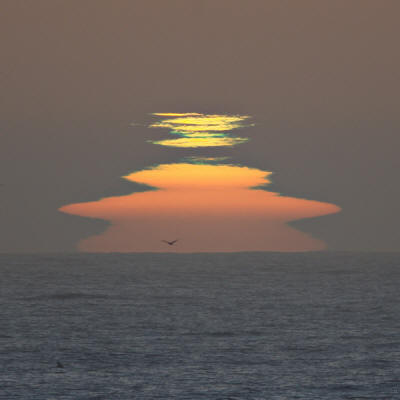 |
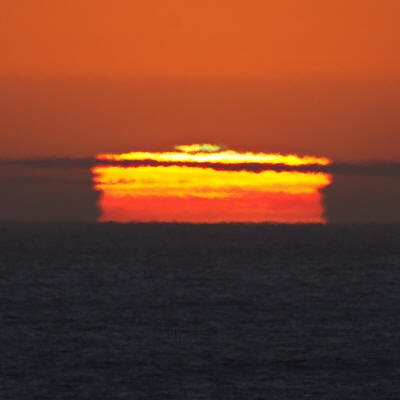 |
||
| "Mondo" Green Flash; by far the largest that I have observed. | A "mock mirage" sunset with pancake layers as the sun's light traverses multiple layers of the atmosphere. | ||
|
|
|||
| A rare "Blue Flash". | Histogram of the Blue Flash image, with a sharp
spike in the blue spectrum. |
||
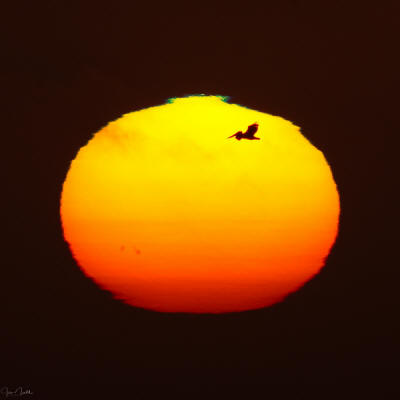 |
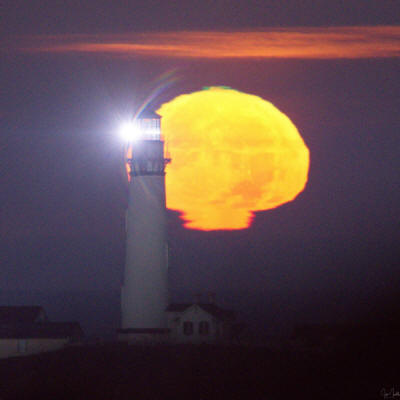 |
||
| A green segment right before it optically detachs from the sun's disk. The pelican was a nice bonus. | A lunar green flash as the moon sets at Pigeon Point Lighthouse, with the added bonus of a mock mirage below the moon's disk. | ||
 |
 |
||
| A surprise flash just before the sun set. | A distinct post-sunset green flash. | ||
 |
Typical setup for good Green Flash viewing with a coastal inversion during offshore flow. The layers of different densities (i.e., cooler and warmer air) refract the setting sun's light differently. |
||
| Triple Green Flash | |||
|
Additional Technical References: - Atmospheric Optics - https://www.atoptics.co.uk/atoptics/gf1.htm - Andrew Young's Green Flash pages - https://aty.sdsu.edu/ Contact me at jnull@ggweather.com with any questions of comments. |
|||
Return to Golden Gate Weather Service
Copyright © 2022, Golden Gate Weather Services.
Reproduction in full or part is prohibited without
permission.